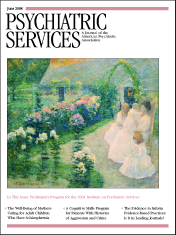Course of Patients With Histories of Aggression and Crime After Discharge From a Cognitive-Behavioral Program
Abstract
OBJECTIVE: Patients exhibiting aggressive or criminal behavior present a challenge to treaters and caregivers. After discharge from an inpatient facility, such patients are at high risk of rehospitalization and rearrest. A long-term behaviorally based cognitive skills program was developed and administered to a group of such high-risk inpatients. The authors report the results of a postdischarge follow-up of this group. METHODS: After patients entered the inpatient treatment program, their psychiatric and criminal histories were recorded, and a battery of psychological measures were administered, including IQ tests and the Hare Psychopathy Checklist. After discharge, multiple sources were used to obtain information about patients' outcomes. RESULTS: Eighty-five patients were followed for between six months and two years after discharge. Thirty-three of these patients (39 percent) remained stable in the community, 35 (42 percent) were rehospitalized, and 17 (20 percent) were arrested. Several variables that were ascertained before discharge predicted rehospitalization or arrest rates: comorbid antisocial personality disorder, higher score on the Psychopathy Checklist, history of arrests for violent crimes, and history of a learning disability. In addition, patients who developed substance use problems or did not adhere to medication treatment after discharge were more likely to be rehospitalized or arrested. CONCLUSIONS:Arrest rates were low compared with those observed in studies with similar populations. Although this outcome may be attributable to the treatment program, this naturalistic study could not prove that. The predictors of poor outcome may be used to develop a follow-up treatment program that focuses more resources on patients who are at the highest risk.



